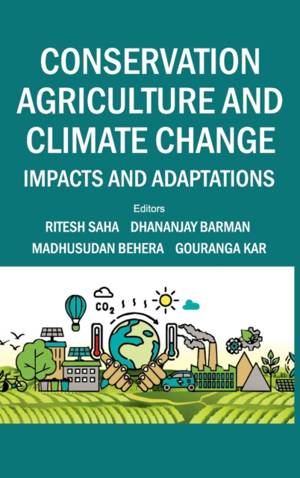
- Retrait gratuit dans votre magasin Club
- 7.000.000 titres dans notre catalogue
- Payer en toute sécurité
- Toujours un magasin près de chez vous
- Retrait gratuit dans votre magasin Club
- 7.000.000 titres dans notre catalogue
- Payer en toute sécurité
- Toujours un magasin près de chez vous
Conservation Agriculture And Climate Change Impacts And Adaptations
Ritesh SahaDescription
Conventional tillage and burning crop residues has degraded the soil resource base and intensified soil degradation with concomitant decrease in crop production capacity. The emerging issue of global warming coupled with greenhouse gases emissions has further aggravated the scenario. Conservation agriculture (CA) helps in reducing many negative effects of conventional agriculture such as soil erosion, soil organic matter (SOM) decline, water loss, soil physical degradation, and fuel use. CA helps to improve biodiversity in the natural and agro-ecosystems. Complemented by other good agricultural practices (GAPs) including the use of quality seeds, integrated pest, nutrient and water management etc., CA provides a base for sustainable intensification of the agricultural production system. Moreover, the yield levels in CA systems are comparable and even higher than traditional intensive tillage systems with substantially less production costs. The conservation agriculture (CA) practiced over an estimated 100 M ha area worldwide and across a variety of climatic, soil and geographic zones, has proved to be energy and input efficient, besides addressing the emerging environment and soil health problems. The CA technologies involving no- or minimum tillage with direct seeding and bed planting, residue management (mainly residue retention) and crop diversification have potential for improving productivity and soil quality, mainly by soil organic matter (SOM) build-up.This bring many possible benefits including reduced water and energy use(fossil fuels and electricity), reduced greenhouse gas (GHG) emissions, soilerosion and degradation of the natural resource base, increased yields and farm incomes, and reduced labour shortages.
Spécifications
Parties prenantes
- Auteur(s) :
- Editeur:
Contenu
- Nombre de pages :
- 496
- Langue:
- Anglais
Caractéristiques
- EAN:
- 9789390591084
- Date de parution :
- 27-08-21
- Format:
- Livre relié
- Format numérique:
- Genaaid
- Dimensions :
- 152 mm x 229 mm
- Poids :
- 825 g







